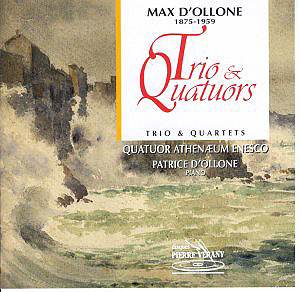 Composer: Max d’Ollone
Composer: Max d’Ollone
Works: Piano Quartet (1949), String Quartet (1898), Piano Trio (1920)
Performers: Patrice d’Ollone (piano), Quatuor Athenaeum
Recording: Enesco rec Jan 1999, Salle des fêtes de l’Académie de Paris
Label: Pierre Verany PV799061
Max d’Ollone, a figure often overshadowed by his contemporaries, emerges from relative obscurity with this compelling recording featuring three of his chamber works. Spanning the late Romantic period, d’Ollone’s compositions reflect a blend of French elegance and Brahmsian depth, marking a significant yet overlooked contribution to the chamber music repertoire. His evolution as a composer is traced through these three works, showcasing distinct stylistic characteristics that range from the lyrical and charming to the robust and complex.
The Piano Trio, composed in 1920, stands out for its cyclic form, where thematic material recurs and evolves throughout the movements. The performers exhibit a commendable grasp of d’Ollone’s intricate contrapuntal textures. The first and second movements exhibit a relaxed demeanor, with melodies that are both engaging and lyrical. In contrast, the Scherzo reveals a darker turbulence, where rhythmic drive takes precedence, culminating in a finale that is both spirited and harmonically adventurous. Here, d’Ollone’s rhythmic inventiveness showcases a deft ability to balance established forms with the burgeoning modernism of the time, hinting at the stylistic shifts that would characterize the 20th century.
The String Quartet, written in 1898, captures the essence of d’Ollone’s early style, rich with the influences of Massenet and Saint-Saëns. This work is particularly notable for its romantic warmth and lyrical flow, with the performers delivering a polished interpretation that highlights the quartet’s melodic richness. The ensemble’s blend is exemplary, maintaining clarity even in the more complex passages. The emotional trajectory is well-articulated, with the second movement unfolding with a gentle melancholy that contrasts effectively with the work’s more exuberant sections. This balance between lyrical expression and structural coherence is a hallmark of d’Ollone’s writing, and it is admirably realized in this performance.
The Piano Quartet, composed in 1949, is the most mature of the three works presented. It resonates with a sense of urgency and vigor, particularly evident in the muscular dotted rhythms of the finale. Patrice d’Ollone’s interpretation as pianist is noteworthy; he navigates the demanding passages with both authority and sensitivity, ensuring that the piano’s voice complements rather than overwhelms the strings. The ensemble’s rapport is palpable, providing a vigorous yet nuanced performance that breathes life into d’Ollone’s rich melodic language. Additionally, the recording quality is commendable, with a clarity that allows each instrumental color to shine through, enhancing the listener’s experience of the intricate interplay among the musicians.
This disc not only reintroduces d’Ollone’s works to a wider audience but also serves as an invitation to explore the depths of his musical language. The combination of strong performances, thoughtful interpretations, and high-quality engineering underscores the vitality and individuality of d’Ollone’s compositions. Such a presentation fosters a renewed appreciation for a composer who, despite his historical neglect, possesses a unique voice worthy of further exploration. The recording stands as a testament to d’Ollone’s artistry, ensuring that this significant figure in French music is no longer relegated to the peripheries of the repertoire.



